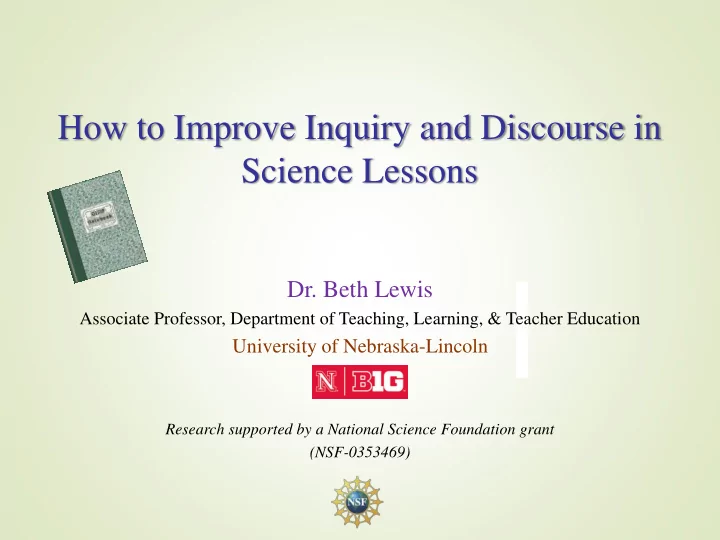

How to Improve Inquiry and Discourse in Science Lessons Dr. Beth Lewis Associate Professor, Department of Teaching, Learning, & Teacher Education University of Nebraska-Lincoln Research supported by a National Science Foundation grant (NSF-0353469)
Session Overview Goals 1. Reflect upon your current teaching practices. 2. Provide research-based resources for teaching and learning science. Activity 1. Designed to improve science lessons with rich oral and written discourse strategies. 2. With repeated use and practice the model can develop cutting-edge teaching practices.
Communication in Science Inquiry Project was originally a National Science Foundation-funded grant for teacher professional development To establish scientific classroom discourse communities
What is a Scientific Classroom Discourse Community (SCDC)? 1. As an individual, on your handout, define a scientific classroom discourse community. • What are teachers doing? • What are students doing? • How is a SCDC different from other discourses? • Don’t answer #3, yet 2. Turn to the person nearest to you and briefly share your ideas.
Key Aspects of a SCDC Teachers learn about specific instructional strategies to build a scientific classroom discourse community Scientific inquiry and communication in science Oral and written discourse are situated within scientific inquiry Academic language development supports the learning of science Learning principles from How People Learn (NRC, 2000)
Classroom Observation Instrument: DiISC “Discourse in Inquiry Science Classrooms” ( DiISC) Developed over 3 years to be aligned with CISIP Has 5 scales with 36 items total: Inquiry (6) Oral discourse (5) Written discourse (6) Academic language development (8) Learning principles (11) Each item scored using a 0 – 3 point rubric Adapted for use for designing science lessons
DiISC Example Items: Scientific Inquiry 2. Teacher engages students in asking scientific questions for the purpose of Observed: 0 1 2 3 investigation (hands-on or other means) Rubric: Teacher provides students opportunities to: 0 = teacher generates question or no investigation a) formulate questions about the natural 1 = limited opportunity; rote “cookbook” activity world 2 = students directed to form scientific questions b) present explanations for questions to be investigated c) distinguish between scientific and non- 3 = students form and explain reasoning behind scientific questions the scientific questions for their investigation 3. Opportunities for students to design and plan exploration of the natural world Observed: 0 1 2 3 individually or in groups Teacher provides opportunities and guidance Rubric: to: 0 = no activity or activity has a set procedure a) plan and conduct scientific investigations 1 = students are all expected to design the same individually procedure b) plan and conduct scientific investigations 2 = students design a procedure but are not in groups required to justify c) justify procedures before carrying out 3 = students design, plan, and justify their investigations approach to exploration of a topic
Mini-Professional Development 1. Return to your prior knowledge handout and review your responses. 2. From the five categories of the CISIP model, read each teaching strategy card you received: Yellow = Inquiry Blue = Oral discourse Green = Written discourse Pink = Academic language development Purple = Learning principles
Example of a Redesigned Lesson on the Water Cycle
Mini-Professional Development ( con’t ) 3. Think of a lesson/unit you recently taught. 4. Revise the lesson using the 5 strategies you were given. 5. Share your ideas with the person next to you. 6. Return to your worksheet and identify any changes to your ideas about a SCDC (#1). 7. Now, answer #3 on your handout: • How could you build a SCDC with your students? • What would your priorities be?
Activity article available at: http://digitalcommons.unl.edu/teachlearnfacpub/151/ …contact me for color handouts if you would like them Dr. Beth Lewis Associate Professor, Department of Teaching, Learning, & Teacher Education University of Nebraska-Lincoln ELewis3@UNL.edu
Recommend
More recommend